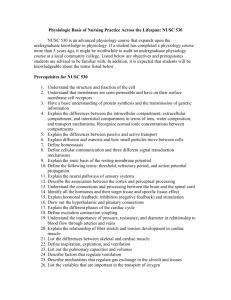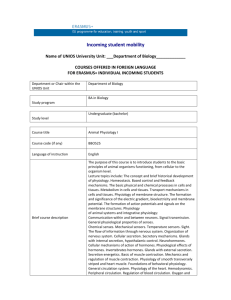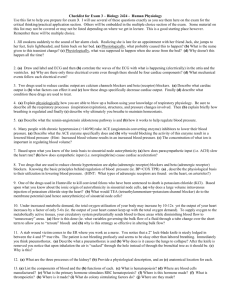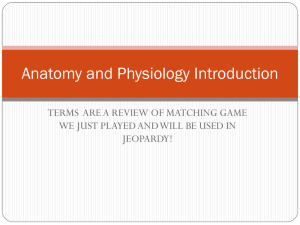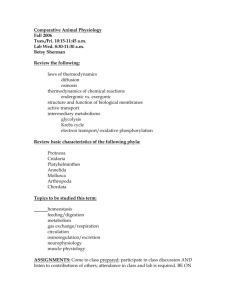20130409-152910
advertisement
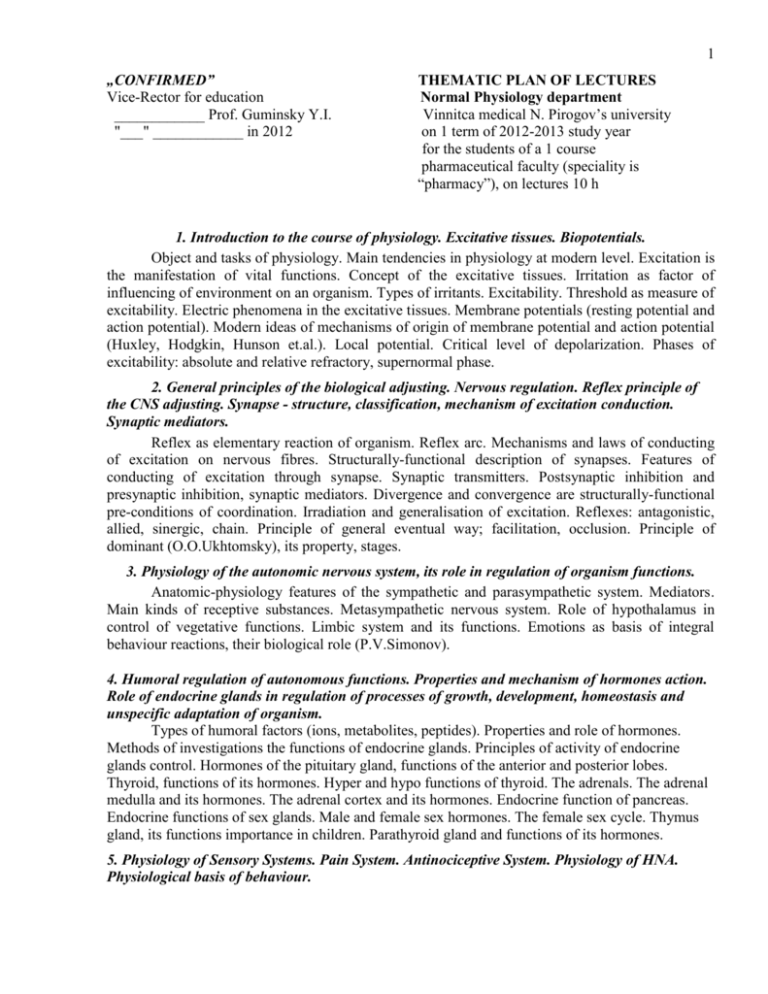
1 „CONFIRMED” Vice-Rector for education ____________ Prof. Guminsky Y.I. "___" ____________ in 2012 THEMATIC PLAN OF LECTURES Normal Physiology department Vinnitca medical N. Pirogov’s university on 1 term of 2012-2013 study year for the students of a 1 course pharmaceutical faculty (speciality is “pharmacy”), on lectures 10 h 1. Introduction to the course of physiology. Excitative tissues. Biopotentials. Object and tasks of physiology. Main tendencies in physiology at modern level. Excitation is the manifestation of vital functions. Concept of the excitative tissues. Irritation as factor of influencing of environment on an organism. Types of irritants. Excitability. Threshold as measure of excitability. Electric phenomena in the excitative tissues. Membrane potentials (resting potential and action potential). Modern ideas of mechanisms of origin of membrane potential and action potential (Huxley, Hodgkin, Hunson et.al.). Local potential. Critical level of depolarization. Phases of excitability: absolute and relative refractory, supernormal phase. 2. General principles of the biological adjusting. Nervous regulation. Reflex principle of the CNS adjusting. Synapse - structure, classification, mechanism of excitation conduction. Synaptic mediators. Reflex as elementary reaction of organism. Reflex arc. Mechanisms and laws of conducting of excitation on nervous fibres. Structurally-functional description of synapses. Features of conducting of excitation through synapse. Synaptic transmitters. Postsynaptic inhibition and presynaptic inhibition, synaptic mediators. Divergence and convergence are structurally-functional pre-conditions of coordination. Irradiation and generalisation of excitation. Reflexes: antagonistic, allied, sinergic, chain. Principle of general eventual way; facilitation, occlusion. Principle of dominant (О.О.Ukhtomsky), its property, stages. 3. Physiology of the autonomic nervous system, its role in regulation of organism functions. Anatomic-physiology features of the sympathetic and parasympathetic system. Mediators. Main kinds of receptive substances. Metasympathetic nervous system. Role of hypothalamus in control of vegetative functions. Limbic system and its functions. Emotions as basis of integral behaviour reactions, their biological role (P.V.Simonov). 4. Humoral regulation of autonomous functions. Properties and mechanism of hormones action. Role of endocrine glands in regulation of processes of growth, development, homeostasis and unspecific adaptation of organism. Types of humoral factors (ions, metabolites, peptides). Properties and role of hormones. Methods of investigations the functions of endocrine glands. Principles of activity of endocrine glands control. Hormones of the pituitary gland, functions of the anterior and posterior lobes. Thyroid, functions of its hormones. Hyper and hypo functions of thyroid. The adrenals. The adrenal medulla and its hormones. The adrenal cortex and its hormones. Endocrine function of pancreas. Endocrine functions of sex glands. Male and female sex hormones. The female sex cycle. Thymus gland, its functions importance in children. Parathyroid gland and functions of its hormones. 5. Physiology of Sensory Systems. Pain System. Antinociceptive System. Physiology of HNA. Physiological basis of behaviour. 2 Localization of functions in cortex of the large hemispheres. ЕЕG - as one of methods of the cortex state estimation. Studies about analyzers (І.P.Pаvlov). Modern ideas of sensory systems organization. Pain reception. Biological importance of a pain. Classification of a pain. Functional description of pain’s reception. Neurophisiological mechanisms of pain. Antinociceptive system. General description of the visual reception. Refraction; еmmеtropic eye and anomalies of refraction. Accomodation, its mechanisms. Pupillary reflexes. Photochemistry processes in a retina. Adaptation. Visual field. Colour vision. Acoustic sensory system, role of external, middle and internal ear. Моrрhо-functional description of vestibular sensor system. Reflexes conditioned and unconditioned, their differences. Classification of conditioned reflexes. Terms and mechanisms of conditional reflexes formation. Types of conditioned reflexes inhibition: external (unconditioned) and internal (conditional). Conditioned inhibition, its types. Memory, its types and mechanisms. Structures of brain, participating in the memory formation. Sleep, its importance, dreems. Sleep is orthodox and paradoxical. Modern theories of sleep mechanisms. The Pavlovian studies about the types of higher nervous activity. Properties of nervous processes, fixed in basis of division on types; their classification as compared of temperaments in the man. Functional asymmetry of the large hemispheres cortex. Chief of the Normal Physiology department Prof. V.М. Моrоz. 3 „CONFIRMED” Vice-Rector for education ____________ Prof. Guminsky Y.I. "___" ____________ in 2012 THEMATIC PLAN OF LECTURES Normal Physiology department Vinnitca medical N. Pirogov’s university on 2 term of 2012-2013 study year for the students of a 1 course pharmaceutical faculty (speciality is “pharmacy”), on lectures 10 h 1. Physico-chemical properties of blood. Composition and functions of blood. Antigen properties of blood. Blood groups. Physiological basis of hemotransfusion and blood substitutes Functions of blood. Quantity, composition and properties of blood. Functions of erythrocytes. Haemoglobin and its properties. Forms and connections of haemoglobin. Myoglobin. Functions of leukocytes; Т- and В- lymphocytes. Thrombocytes, its structure and functions. Plasma of blood and its composition. Osmotic pressure and its role. Solutions: iso-, hypo- and hypertonic. Osmotic fragility of erythrocytes. Haemolysis. Oncotic pressure and its role. Erythrocyte sedimentation rate (ЕSR). Active reaction of blood (pH). Acidosis and alkalosis. Buffer systems of blood. System, which supports the liquid aggregate state of blood. Prevention of blood coagulation in the normal vascular system. The intravascular anticoagulants. Coagulation of blood. Formation of the platelet plug. Coagulative hemostasis, its stages. Studies about specificity of albumen of plasma and its value for blood transfusion. Blood groups (АВО) and methods of their determination. Rhesus factor (Rh) of blood. 2. Respiratory system. Physiological mechanisms of stages of respiration. External respiration and methods of its investigation. Transport of gases by blood. Regulation of the respiration. Pharmacological mechanisms of the respiratory disorders control. Stages of respiration. Role of the external respiration (breathing). Pulmonary ventilation and factors it conditioned by. Pressure in a pleural cavity. Elastic tension of lung tissue. Role of surfactants. Mechanism of inspiration and expiration. Classification of respiratory volumes. Vital capacity of the lungs. Dead space. Compositions of inspired, expired and alveolar air; value of their measuring. Partial pressure and tension of gases in these volumes is air, in a blood and tissues. Interchange of gases between alveolar air and blood, blood and tissues. Connection and the transfer of O2 and CO2 by blood. Medullary-pontine respiratory centre. Role of the tension СО2, О2 and other humoral factors in control of respiration. Reflexes in control of respiration. 3. The system of the blood circulation. Physiological properties and features of the cardiac muscle. The main principles of hemodynamic. Blood pressure. Control of cardiac activity and hemodynamic. Methods of the pharmacological correction of cardio-vascular disorders. Classic chart of haemodynamics by Harvey. Heart, its structurally-functional features. Conducting system of heart. Automatism of the heart. Analysis of myocardium excitability, excitation and contractility correlation and their clinical importance. Contractility of the cardiac muscle. Systolic and minute volumes of heart as indexes of force and work of heart, principles of their determination. Phase analysis of cardiac cycle. Pressure in cavities of heart and main vessels of thorax cavity in different phases of the cardiac cycle. Heart sounds, their description and origin. 4 Electrocardiogram (ЕCG) and methods of its registration. Mechanism of forming of elements of ЕCG. Functional description of blood vessels (Folkov). Arterial pressure (maximal, minimum, pulse). Factors, which determine level of the arterial pressure. Bloody pressure in different parts of the circulatory system. Volume and linear velocity of the blood flow. Volume and linear velocity in different parts of the circulatory system. Total circulation time, complete and partial; principles of their determination. Arterial pulse and its characteristics. Sphygmogram and its analysis. Capillary circulation. Mechanism and values of transcapillar exchange. Additional factors, help to movement of blood along the veins. Myogenic control of cardiac activity and circulation of blood. Local reflexes of a heart. Influence of sympathetic and parasympathetic nerves on operation of heart. Reflex and humoral control of cardiac activity. Vasomotor nerves, their description. Cardiovascular center, its localization. Humoral control of blood circulation. Local control of vessels tone. 4. The system of digestion. Digestion in a different departments of GIT. Physiological mechanisms of hungry and satiation. Methods of pharmacological correction of GIT functions. General description of a digestion processes. Types of digestion. Functions of the digestive system in the man. Methods of the chronic experiments by I.P.Pavlov and their importance for the development of physiology of digestion. Digestion in a mouth. Saliva, its composition and properties. Mechanisms of salivary secretion. Swallowing. Composition of gastric juice, role of its components in digestion. "Cephalic" (complex-reflex) and neuro-humoral (gastric and intestinal) phases of its secretion. The matters which suppress, excite and indifferent in relation to a gastric secretion; hormones of the DES system. Composition and action of pancreatic juice. Enterokinase (Shepovalnikov). Liver as a poli-functional organ. Composition and properties of a bile. Adjusting of production and ejection of bile. Matters which strengthen and brake of bile secretion and ejection. Intestinal juice and its role in a digestion. Control of secretion of intestinal juice. Membrane (contact) digestion (Ugolev). Digestion in the large intestine. Types of contractions of stomach. Mechanism of evacuation of food from stomach into duodenum. Types of contractions of the small intestine. Features of contractions of the large intestine. Absorption. 5. System of excretion. Mechanism of the urine formation. The kidneys participation in the maintaining of homeostasis. Control of kidneys activity with the participation of pharmacological agents. Excretion as a component of functional system in supportance of homeostasis. Role of skin, lungs, digestive tract in the processes of excretion. Structure and functions of kidneys. Functions of Henle's loop. Urine, its composition a day's volume; origin of urine components. Role and mechanisms of filtration, reabsorption and secretion in formation of primary and secondary urine. Control of urine's formation. Chief of the Normal Physiology department Prof. V.М. Моrоz.
